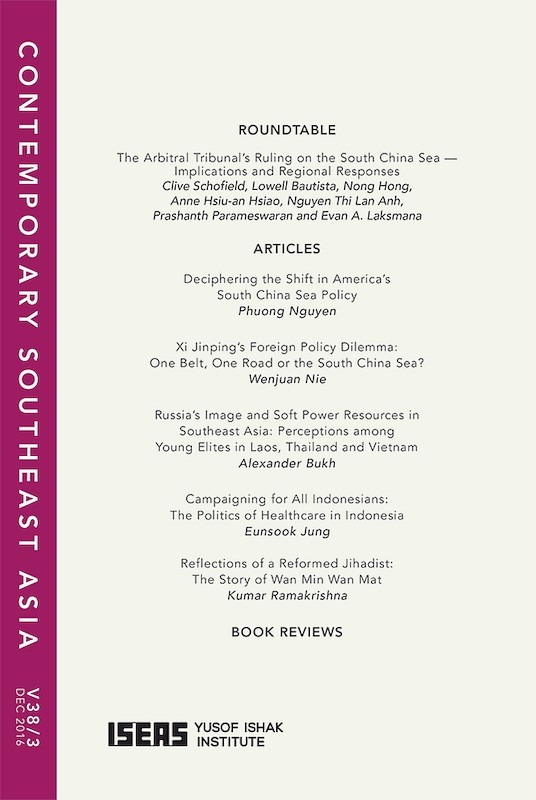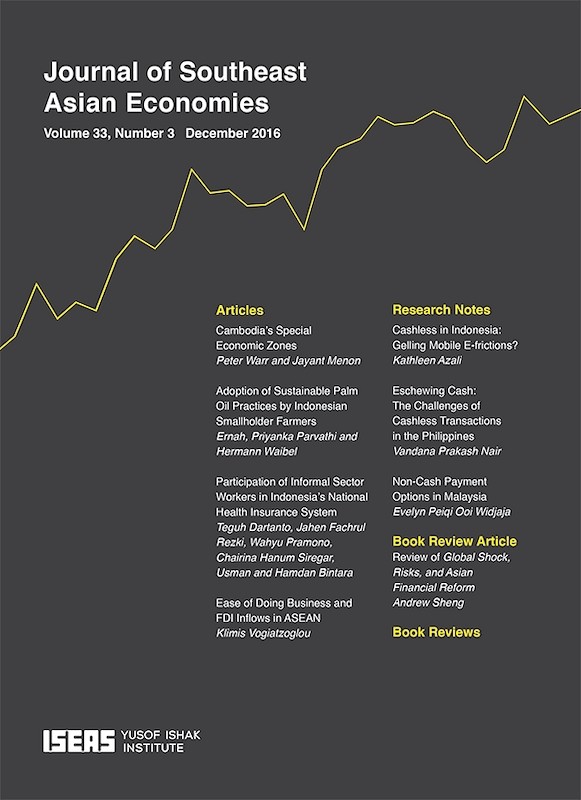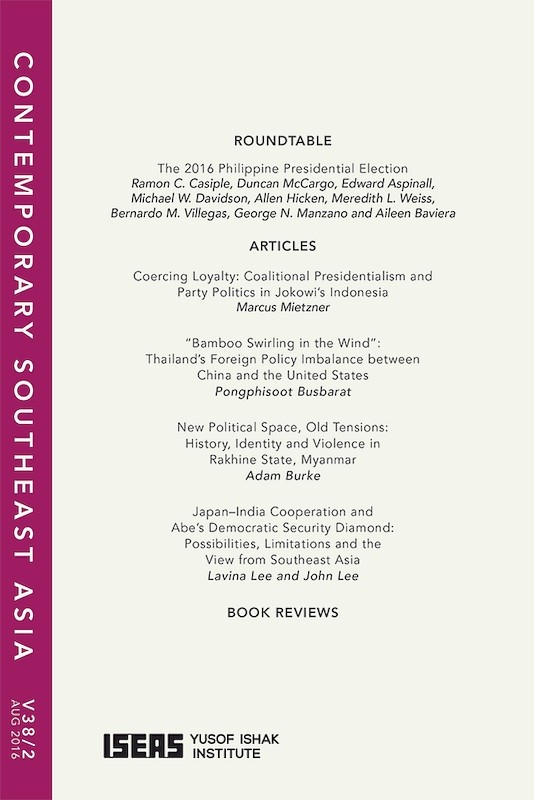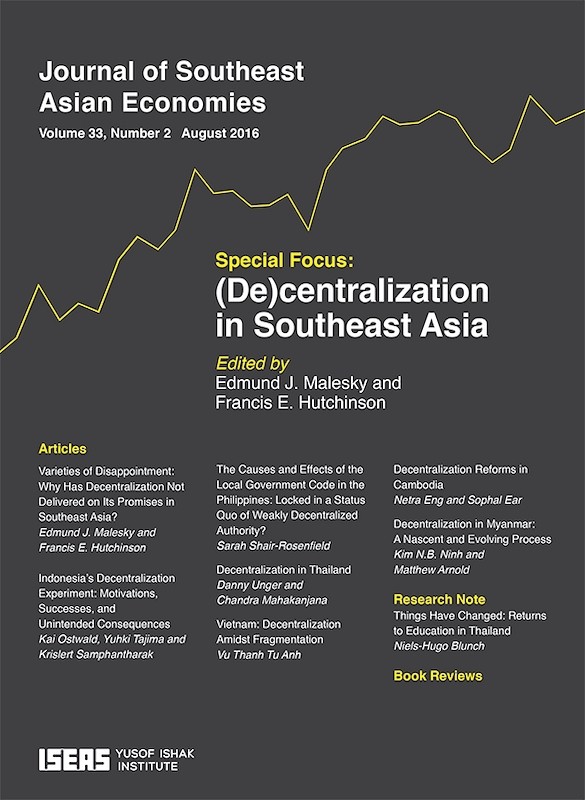Contemporary Southeast Asia Vol. 38/3 (December 2016)

Ian Storey, editor
Date of publication:
December 2016
Publisher:
ISEAS - Yusof Ishak Institute
Number of pages:
212
Code:
CS38/3
About the publication
- Attained impact factor of 0.906 in Social Sciences Citation Index 2017
- Ranked 18th by Google Scholar Metrics 2018 in the Asian Studies and History category
Contents
-
Contemporary Southeast Asia Vol. 38/3 (December 2016)
[Whole Publication, ISSN: 1793284X] -
Preliminary pages
- ROUNDTABLE
-
1. Roundtable: The Arbitral Tribunal's Ruling on the South China Sea - Implications and Regional Responses, by Clive Schofield, Lowell Bautista, Nong Hong, Anne Hsiu-an Hsiao, Nguyen Thi Tuong Anh, Prashanth Parameswaran, Evan A. Laksmana, authors
- ARTICLES
-
2. Deciphering the Shift in America's South China Sea Policy, by Phuong Nguyen, author see abstract<div><font face="helvetica, arial, verdana, sans-serif"><span style="font-size: 13px;">China’s massive reclamation work in the disputed Spratly Islands in </span></font><span style="font-size: 13px; font-family: helvetica, arial, verdana, sans-serif;">the South China Sea between 2013 and 2015 was a turning point in </span><span style="font-size: 13px; font-family: helvetica, arial, verdana, sans-serif;">US policy towards the South China Sea. China intends to use the </span><span style="font-size: 13px; font-family: helvetica, arial, verdana, sans-serif;">artificial islands it has constructed — and the infrastructure it is in </span><span style="font-size: 13px; font-family: helvetica, arial, verdana, sans-serif;">the process of installing on them — for military purposes. While for </span><span style="font-size: 13px; font-family: helvetica, arial, verdana, sans-serif;">many years the United States largely positioned itself above the long-simmering </span><span style="font-size: 13px; font-family: helvetica, arial, verdana, sans-serif;">territorial and maritime jurisdictional disputes between </span><span style="font-size: 13px; font-family: helvetica, arial, verdana, sans-serif;">China and five Southeast Asian countries, the prospect of China </span><span style="font-size: 13px; font-family: helvetica, arial, verdana, sans-serif;">using its buildup in the southern reaches of the South China Sea to </span><span style="font-size: 13px; font-family: helvetica, arial, verdana, sans-serif;">establish greater control of its near seas, in the process diminishing </span><span style="font-size: 13px; font-family: helvetica, arial, verdana, sans-serif;">US access to the waters and airspace of the world’s most critical </span><span style="font-size: 13px; font-family: helvetica, arial, verdana, sans-serif;">waterways, prompted a reassessment in Washington about the South </span><span style="font-size: 13px; font-family: helvetica, arial, verdana, sans-serif;">China Sea being part of larger US core interests, and its grand </span><span style="font-size: 13px; font-family: helvetica, arial, verdana, sans-serif;">strategy in the Western Pacific. Washington has responded to China’s </span><span style="font-size: 13px; font-family: helvetica, arial, verdana, sans-serif;">reclamation and construction spree with a new, active strategy that </span><span style="font-size: 13px; font-family: helvetica, arial, verdana, sans-serif;">aims to deter China from taking further actions at its reclaimed </span><span style="font-size: 13px; font-family: helvetica, arial, verdana, sans-serif;">features that would alter the existing military balance of power in the </span><span style="font-size: 13px; font-family: helvetica, arial, verdana, sans-serif;">region and make China pay a “net effect” for its behaviour — should </span><span style="font-size: 13px; font-family: helvetica, arial, verdana, sans-serif;">it continue to pursue an aggressive course of actions — by engaging </span><span style="font-size: 13px; font-family: helvetica, arial, verdana, sans-serif;">more actively with Southeast Asian partners.</span></div>
-
3. Xi Jinping's Foreign Policy Dilemma: One Belt, One Road or the South China Sea?, by Wenjuan Nie, author see abstract<div><font face="helvetica, arial, verdana, sans-serif"><span style="font-size: 13px;">This article utilizes the elements of leadership, political performance </span></font><span style="font-size: 13px; font-family: helvetica, arial, verdana, sans-serif;">and national interests to understand China’s foreign policy decision-making </span><span style="font-size: 13px; font-family: helvetica, arial, verdana, sans-serif;">process. In contrast to a state-centred analysis, this article </span><span style="font-size: 13px; font-family: helvetica, arial, verdana, sans-serif;">assumes that the supreme leadership’s view of political performance </span><span style="font-size: 13px; font-family: helvetica, arial, verdana, sans-serif;">is the most important factor when it comes to foreign policy decision-making. </span><span style="font-size: 13px; font-family: helvetica, arial, verdana, sans-serif;">It contends that so-called national interests are often </span><span style="font-size: 13px; font-family: helvetica, arial, verdana, sans-serif;">manipulated to serve particular political agendas. Specifically, this </span><span style="font-size: 13px; font-family: helvetica, arial, verdana, sans-serif;">article explores whether the One Belt, One Road (OBOR) initiative </span><span style="font-size: 13px; font-family: helvetica, arial, verdana, sans-serif;">or advancing China’s interests in the South China Sea can be better </span><span style="font-size: 13px; font-family: helvetica, arial, verdana, sans-serif;">utilized to improve Chinese President Xi Jinping’s political performance. </span><span style="font-size: 13px; font-family: helvetica, arial, verdana, sans-serif;">The comparison between the two issues incorporates the dimensions of </span><span style="font-size: 13px; font-family: helvetica, arial, verdana, sans-serif;">feasibility, significance and morality. In the final analysis, this article </span><span style="font-size: 13px; font-family: helvetica, arial, verdana, sans-serif;">finds that the OBOR is likely to be better utilized to enhance Xi’s </span><span style="font-size: 13px; font-family: helvetica, arial, verdana, sans-serif;">political performance, which yields some salient implications for future </span><span style="font-size: 13px; font-family: helvetica, arial, verdana, sans-serif;">trends in China’s foreign policy.</span></div>
-
4. Russia's Image and Soft Power Resources in Southeast Asia: Perceptions among Young Elites in Laos, Thailand and Vietnam, by Alexander Bukh, author see abstract<div><font face="helvetica, arial, verdana, sans-serif"><span style="font-size: 13px;">Since the early 2000s, “soft power” has become one of the most </span></font><span style="font-size: 13px; font-family: helvetica, arial, verdana, sans-serif;">popular analytical tools in International Relations scholarship devoted </span><span style="font-size: 13px; font-family: helvetica, arial, verdana, sans-serif;">to analyzing the influence of states in the international arena. Although </span><span style="font-size: 13px; font-family: helvetica, arial, verdana, sans-serif;">scholars of Russian foreign policy have also embraced the notion of </span><span style="font-size: 13px; font-family: helvetica, arial, verdana, sans-serif;">“soft power”, they have mainly limited the scope of their analysis to </span><span style="font-size: 13px; font-family: helvetica, arial, verdana, sans-serif;">Western countries and the former Soviet republics. In contrast, this </span><span style="font-size: 13px; font-family: helvetica, arial, verdana, sans-serif;">article focuses on Laos, Vietnam and Thailand, countries whose history </span><span style="font-size: 13px; font-family: helvetica, arial, verdana, sans-serif;">of relations with Russia are fundamentally different from both the</span><span style="font-size: 13px; font-family: helvetica, arial, verdana, sans-serif;">West and Russia’s “near abroad”. By analyzing the images of Russia </span><span style="font-size: 13px; font-family: helvetica, arial, verdana, sans-serif;">and its soft power resources in these countries, this article seeks to </span><span style="font-size: 13px; font-family: helvetica, arial, verdana, sans-serif;">create a more comprehensive understanding of the ways contemporary </span><span style="font-size: 13px; font-family: helvetica, arial, verdana, sans-serif;">Russia is perceived in the world and its potential tools of influence in </span><font face="helvetica, arial, verdana, sans-serif">Southeast Asia. Drawing on the results of a survey conducted among </font>university students, this article examines the ways young educated elites in the three countries perceive Russia. It also explores the degree of correspondence between these images and the self-image of Russia espoused by its political elites. The results of this study suggest that while overall Russia is perceived as a Great Power, and its role in the world is seen as mostly positive, there are also important dissonances between the two images. Based on discernible differences among the three groups of respondents in the ways they perceive Russia, the article also suggests that historical memory plays an important role in shaping these perceptions.</div>
-
5. Campaigning for All Indonesians: The Politics of Healthcare in Indonesia, by Eunsook Jung, author see abstract<div><font face="helvetica, arial, verdana, sans-serif"><span style="font-size: 13px;">Many scholars argue that democratization is conducive to the </span></font><span style="font-size: 13px; font-family: helvetica, arial, verdana, sans-serif;">development of social welfare policies and that democracy brings about redistributive reform due to demands from the newly enfranchised poor. In reality, however, democratization does not necessarily bring about comprehensive social welfare reform. If not democratization, what explains social welfare expansion in developing countries? This article examines Indonesia, which began the process of democratization in 1998 following the fall of President Soeharto, and which has since become a stable democracy with a consistently growing economy. More than a decade after Soeharto’s resignation, Indonesia started to implement a comprehensive healthcare policy. What explains the gap between the enactment and the implementation of this social policy reform? In answering this question, I argue that electoral competition alone does not shape social policy reform. Instead, social reform has institutional prerequisites, such as the broad- based organization of its advocates. A broad-based organization goes beyond its narrow interests, builds cross-class alliance and pressures the government. Without this prerequisite, democratization does not </span><span style="font-size: 13px; font-family: helvetica, arial, verdana, sans-serif;">necessarily result in comprehensive social reforms.</span></div>
-
6. Reflections of a Reformed JIhadist: The Story of Wan Min Wan Mat, by Kumar Ramakrishna, author see abstract<div><font face="helvetica, arial, verdana, sans-serif"><span style="font-size: 13px;">On 29 August 2012, a rehabilitated former senior member of the </span></font><font face="helvetica, arial, verdana, sans-serif" style="font-size: 12px;"><span style="font-size: 13px;">Jemaah Islamiyah (JI) terror network, Wan Min Wan Mat, delivered a lecture to a group of Malaysian counter-terrorism practitioners in which he sketched out the ideological rationale and aims of the JI network, unpacked in some detail its recruitment and indoctrination philosophy and methodology and also examined what in his personal view are potentially useful strategies for rehabilitating JI militants or preventing the further dissemination of JI extremist ideas. This article examines and evaluates some of the key insights made by Wan Min in his lecture, and argues that his musings are more than mere historical interest in that they have direct relevance to the current struggle against the latest incarnation of the continually evolving violent jihadist threat in Southeast Asia and globally, namely the Islamic State of Iraq and Syria (ISIS or IS). The central reason for this is that the same broad ideology that animated JI —Salafi Jihadism </span></font><span style="font-size: 13px; font-family: helvetica, arial, verdana, sans-serif;">— basically motivates ISIS as well. Hence, even allowing for dissimilarities in time and space, Wan Min’s insights about JI could well provide useful pointers for counter-terrorism practitioners and </span><span style="font-size: 13px; font-family: helvetica, arial, verdana, sans-serif;">specialists dealing with the ISIS threat today."</span></div>
- BOOK REVIEWS
-
BOOK REVIEW: The Pivot: The Future of American Statecraft in Asia. By Kurt M. Campbell, by Simon Long, author
-
BOOK REVIEW: Thai Politics: Between Democracy and Its Discontents. By Daniel H. Unger and Chandra Mahakanjana, by Aim Sinpeng, author
-
BOOK REVIEW: Democratization through Migration? Political Remittances and Participation of Philippine Return Migrants. By Christl Kessler and Stefan Rother, by Carmel V. Abao, author
-
BOOk REVIEW: Governing Cambodia's Forests: The International Politics of Policy Reform. By Andrew Cock BOOK REVIEW: Cambodia's Second Kingdom: Nation, Imagination, and Democracy. By Astrid Noren-Nilsson, by Sophal Ear, author
-
BOOK REVIEW: Activism and Aid: Young Citizens' Experiences of Development and Democracy in Timor-Leste. By Ann Wigglesworth, by Angie Bexley, author
-
BOOK REVIEW: The Politics of Aid to Burma: A Humanitarian Struggle on the Thai-Burmese Border. By Anne Decobert, by Carine Jaquet, author
-
BOOK REVIEW: The Handbook of Contemporary Cambodia. Edited by Katherine Brickell and Simon Springer, by Veronika Stepkova, author
-
BOOK REVIEW: Humanizing the Sacred: Sisters in Islam and the Struggle for Gender Justice in Malaysia. By Azza Basarudin, by Rusaslina Idrus, author






